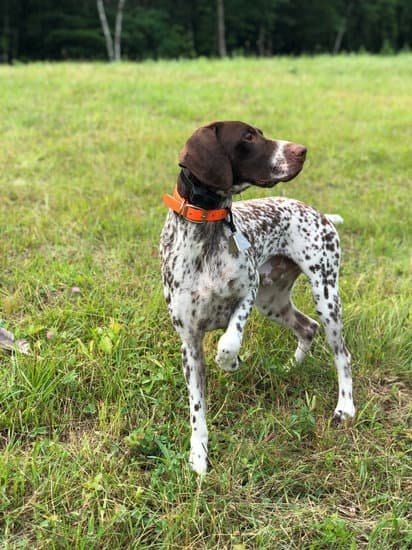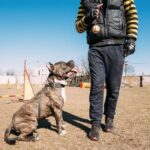Do you ever wonder how to train dogs to track? Tracking is an incredible skill that taps into a dog’s natural instincts and abilities. In this article, we will explore the purpose of tracking and its importance in a dog’s development. Understanding why tracking is essential for dogs will give us insight into the significance of training them in this skill.
When it comes to tracking, not all dog breeds are created equal. We’ll discuss the best breeds for tracking and the qualities to look for in a tracking dog. Additionally, we’ll highlight the importance of laying a solid foundation through basic obedience training before diving into specific tracking techniques.
Dogs have an extraordinary sense of smell, making them naturally adept at tracking scents. We’ll take a closer look at how to introduce dogs to different scents and lay the groundwork for their tracking journey. With these foundational concepts in mind, let’s explore step-by-step guidance on how to begin training a dog to track effectively.
Choosing the Right Breed
When it comes to training a dog to track, choosing the right breed is crucial to ensuring success in the endeavor. While all dogs have some level of olfactory ability, certain breeds are known for their exceptional tracking skills. Some of the best dog breeds for tracking include Bloodhounds, German Shepherds, Belgian Malinois, Labrador Retrievers, and Beagles. These breeds possess the natural instincts and physical attributes that make them well-suited for tracking work.
Qualities to Look for in a Tracking Dog
In addition to considering the breed, there are specific qualities that individuals should look for when selecting a dog for tracking training. One of the most important qualities is a strong food or play drive, as this motivation will be essential during the training process.
Additionally, dogs with high energy levels and an eagerness to problem solve tend to excel in tracking activities. Tracking dogs should also exhibit focus and determination when following scents, as well as an overall good temperament and sociability.
Physical attributes are also important in a tracking dog. A sturdy build and good musculature will enable the dog to endure long hours of physical activity while staying alert and focused on the task at hand. Furthermore, a keen sense of smell is essential; however, this quality can vary significantly across different breeds and individual dogs. For this reason, it may be necessary to evaluate each dog’s scenting abilities before embarking on serious tracking training efforts.
Basic Obedience Training
Before diving into tracking training, it is crucial to emphasize the significance of basic obedience training for dogs. Establishing a solid foundation in obedience is essential as it lays the groundwork for successful tracking training. Obedience commands such as sit, stay, come, and heel are fundamental in building communication and trust between the handler and the dog. A well-behaved and obedient dog will be more receptive to learning new skills and commands during tracking training.
Additionally, basic obedience training helps to establish control over the dog, especially in distracting environments. Dogs that have not received proper obedience training may struggle with focus and discipline during tracking exercises if they have not been taught how to respond to basic commands consistently. The ability to maintain focus despite various distractions is vital for effective tracking work, making obedience training an indispensable precursor to tracking activities.
Furthermore, basic obedience training provides mental stimulation for dogs, fulfilling their need for structure and purpose. By engaging in consistent obedience exercises, dogs become more receptive to learning new skills, including those required for effective tracking. Overall, a well-behaved dog with a strong foundation in obedience is better equipped for success in tracking training.
| Importance | Benefits |
|---|---|
| Lays groundwork for successful tracking training | Establishes control over the dog |
| Builds communication and trust between handler and dog | Provides mental stimulation for dogs |
Introduction to Scent
The sense of smell for dogs is one of the most powerful and important senses they possess. It’s estimated that a dog’s sense of smell is between 10,000 to 100,000 times more acute than humans. This incredible sense of smell makes them excellent candidates for learning tracking skills. When training a dog to track, it’s essential to understand the significance of their olfactory abilities and how to introduce them to tracking scents effectively.
Understanding the Canine Olfactory System
The canine olfactory system is a marvel of nature, consisting of approximately 300 million scent receptors in their noses compared to 5-6 million in human noses. Dogs also have a specialized organ called the vomeronasal organ, also known as Jacobson’s organ, which allows them to detect pheromones and other specific scents. This remarkable olfactory system is what enables dogs to be such proficient trackers.
Introducing Tracking Scents
The first step in training a dog to track involves introducing them to different types of scent and associating those scents with the act of tracking. An effective way to do this is by using scent articles, which are items that carry the desired scent for the dog to track. By allowing the dog to sniff and become familiar with these scents, they will begin to recognize and follow them once tracking training commences.
Using Positive Reinforcement
When introducing tracking scents to your dog, it’s crucial to use positive reinforcement techniques such as treats or praise. By rewarding your dog every time they show interest in or actively follow a specific scent, you are reinforcing the connection between that scent and a positive outcome. This association will encourage your dog’s natural tracking instincts and make them more eager and enthusiastic about tracking training overall.
Getting Started
Training a dog to track can be an exciting and rewarding experience. Before starting the actual tracking training, it is crucial to ensure that your dog has a solid foundation in basic obedience training. This includes commands such as sit, stay, come, and heel. These basic commands will form the basis of your tracking training and will make it easier for your dog to understand what is expected of them during the tracking process.
Once your dog has a good grasp of basic obedience commands, you can start introducing them to the scent that they will be tracking. One way to do this is by using a scented article such as a piece of cloth with a specific scent on it. Allow your dog to sniff the scented article while associating it with positive reinforcement, such as treats or praise.
After introducing your dog to the scent, you can begin with simple tracking exercises. Start by having someone hold your dog while you walk a short distance away and drop the scented article on the ground. Then return to your dog and give them the command to “find” or “track.” Encourage them along the track with verbal cues and gestures, and reward them enthusiastically when they successfully find the scented article.
| Training Stage | Description |
|---|---|
| Obedience Training | Ensure that your dog has mastered basic obedience commands before beginning tracking training. |
| Scent Introduction | Introduce your dog to the specific scent they will be tracking using positive reinforcement techniques. |
| Basic Tracking Exercises | Start with simple exercises where you drop a scented article and give your dog verbal cues to track it. |
Remember that patience and consistency are key when training dogs to track. As they become more proficient at following the initial scent introduction and basic commands, you can gradually move on to more challenging tracking exercises. Keep in mind that every dog learns at their own pace, so be sure to tailor your training approach according to your dog’s individual progress and needs.
Advanced Tracking Techniques
Training a dog to track is a fascinating process that allows dog owners to explore the natural instincts and abilities of their canine companions. As dogs have an incredible sense of smell, it is important to take advantage of this ability by introducing more advanced tracking techniques to further improve their tracking abilities.
One of the most advanced methods for improving a dog’s tracking skills is scent discrimination. This training technique involves teaching the dog to differentiate between different scents and follow a specific scent trail while ignoring others.
To start training for scent discrimination, it is essential to use different scent articles or materials, such as cotton swabs, cloths, or items with distinct smells. By gradually introducing these scents and incorporating them into the tracking process, dogs can learn to focus on a specific scent and follow it accurately.
In addition to scent discrimination, exploring different tracking terrains can also enhance a dog’s tracking abilities. Dogs should be exposed to various environments such as wooded areas, urban settings, and open fields during their training. This exposure helps them adapt to different challenges they may encounter when tracking in real-life scenarios. The diversity in terrains also trains their senses to follow scents across different surfaces and conditions, ultimately improving their overall tracking skills.
Overall, implementing more advanced techniques such as scent discrimination and exposing dogs to different terrains will continue to develop and diversify their tracking capabilities. Through consistent practice and patience, dogs can become proficient trackers capable of navigating through various surroundings with precision and reliability.
- Introduce different scent articles for scent discrimination training
- Expose dogs to wooded areas, urban settings, open fields for diverse terrain tracking
- Consistent practice and patience are crucial for developing advanced tracking skills
Tracking Equipment
When it comes to training dogs to track, having the right equipment is crucial for success. Here are some essential items you will need to have on hand for tracking training:
– **Harness:** A well-fitted harness is essential for tracking training, as it allows the dog to move freely and comfortably while pulling or following a trail. Look for a harness specifically designed for tracking, with padding and adjustable straps for a secure fit.
– **Long Lines:** Long lines are an important tool for teaching a dog to track at a distance. These long leads allow you to give the dog more freedom while still maintaining control during training sessions. Opt for a strong, durable long line that is at least 30 feet in length.
– **Scent Articles:** Scent articles are used to introduce the dog to different scents and establish a connection between the scent and the act of tracking. These can include items like cloths or rags that have been scented with specific odors. It’s important to have multiple scent articles on hand for training variety.
In addition to these key pieces of equipment, it’s also important to have treats or rewards for positive reinforcement during tracking training sessions. With the right tools and positive reinforcement techniques, you can set your dog up for success in learning how to track effectively.
Troubleshooting
In conclusion, training dogs to track can be a rewarding and fulfilling experience for both the dog and the owner. By understanding the natural instincts of dogs and choosing the right breed, owners can set their furry friends up for success in tracking training.
It is important to remember that a solid foundation in obedience training is crucial before beginning tracking training. This will ensure that the dog is responsive to commands and ready to take on the challenges of tracking.
Introduction to scent is a crucial step in the training process as dogs have an incredible sense of smell which can be honed for tracking purposes. Once the basics are covered, owners can move on to advanced tracking techniques to further improve their dog’s abilities. Additionally, having the right equipment such as harnesses, long lines, and scent articles is essential for effective tracking training.
Despite the potential challenges that may arise during tracking training, with patience and dedication from both the owner and the dog, these issues can be overcome. By following a step-by-step approach and being consistent with training, it is possible to address common challenges such as distractions or losing scent trails. Ultimately, with commitment and proper guidance, any dog has the potential to excel in tracking activities.
Frequently Asked Questions
How Do I Train My Dog to Be a Track Dog?
Training a dog to be a tracker involves teaching them to use their sense of smell to follow a specific scent trail. The first step is to build a solid foundation of obedience and control through basic training commands.
Then, the dog can be introduced to scent work by using specific scents and encouraging them to track it. Consistent practice, positive reinforcement, and patience are essential for training a dog to become an effective tracker.
How Are Tracker Dogs Trained?
Tracker dogs are typically trained using a method called scent discrimination training. This involves teaching the dog to differentiate between different scents and follow specific ones while ignoring distractions.
The training process includes familiarizing the dog with various scents, laying scent trails for them to follow, and gradually increasing the difficulty of the tracking scenarios. During training, dogs are also taught how to signal when they have found the source of the scent, such as by sitting or barking.
How Old to Start Training Tracking Dog?
It is generally recommended to start training a tracking dog when they are around 6 months old, as this is when their physical and mental development allows them to focus on more complex tasks. However, some dogs may start learning tracking skills at an earlier age if they show a strong interest in using their sense of smell.
Regardless of age, it’s crucial to begin training gradually and adapt the program based on each individual dog’s abilities and progress.

Welcome to the blog! I am a professional dog trainer and have been working with dogs for many years. In this blog, I will be discussing various topics related to dog training, including tips, tricks, and advice. I hope you find this information helpful and informative. Thanks for reading!





